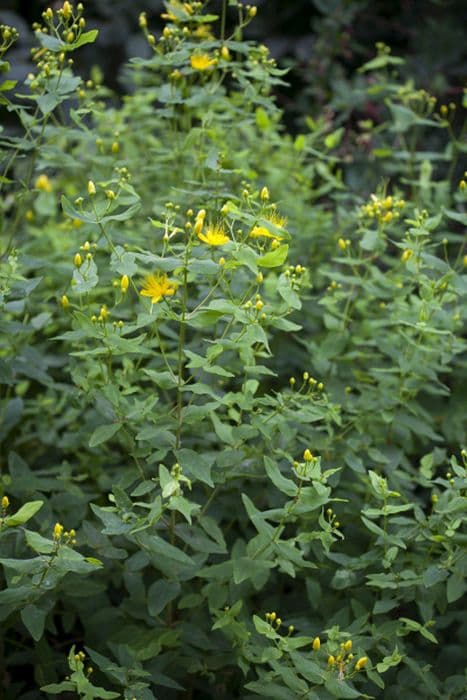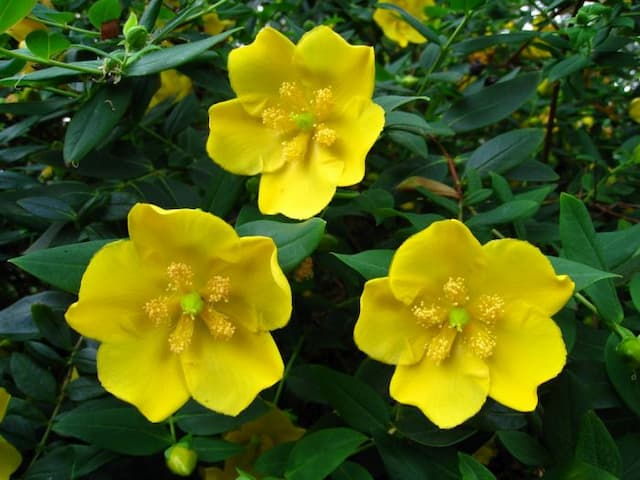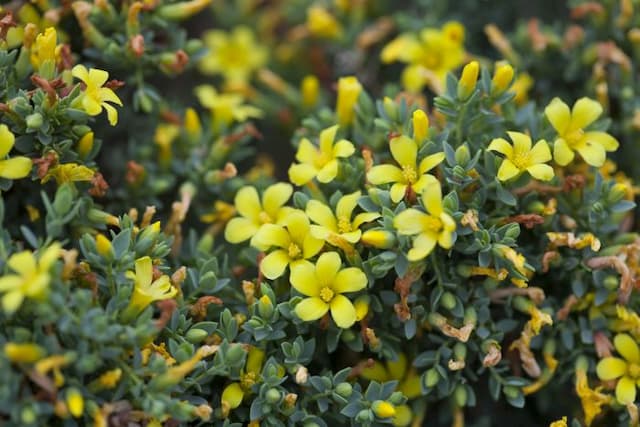Stinking Tutsan Hypericum hircinum

ABOUT
Hypericum hircinum, commonly known as the Stinking Tutsan, is a flowering plant that has a distinctive appearance. The plant boasts an array of yellow flowers that are quite showy when in full bloom. These flowers typically have five petals each and may feature numerous, conspicuous stamens that extend outward, giving the flowers a frilly, textured look. The petals themselves may have black or dark spots, which add to the visual interest of the blooms. The leaves of the Stinking Tutsan are dark green, glossy, and have an elongated, oval shape with a somewhat pointed tip. They are arranged oppositely along the stems, creating a symmetric, orderly appearance. Some describe the leaves as having an aromatic, peculiar scent when crushed, which is not always pleasant - hence the "stinking" descriptor in the common name. The stems of the plant are typically woody at the base, turning more herbaceous and green as they rise toward the flowers. Depending on the plant's stage of growth and the time of year, it may also bear fruit. These fruits can vary in color as they mature, starting as green and turning to a reddish or purplish hue. The fruits are small, berry-like, and may have a glossy finish that catches the light. Overall, the Stinking Tutsan's combination of showy yellow flowers, glossy green foliage, and distinctive scent make it a unique addition to the environments where it thrives.
About this plant
 Names
NamesFamily
Hypericaceae.
Synonyms
Stinking Tutsan, Stinking St. John's Wort.
Common names
Hypericum hircinum.
 Toxicity
ToxicityTo humans
Hypericum hircinum, commonly known as stinking tutsan, has not been predominantly classified as a toxic plant to humans in the mainstream literature. However, since it is a species of Hypericum, it might contain hypericin, as do other species within this genus which can cause photosensitivity when ingested in large quantities. In such cases, symptoms can include skin irritation, especially upon exposure to sunlight. It's also important to note that individual allergies or sensitivities may lead to adverse reactions not broadly documented. So, while the common usage of stinking tutsan does not usually include reports of significant toxicity, as with any plant, caution should be advised, and it should not be ingested.
To pets
Stinking tutsan, or Hypericum hircinum, is not well-known for being a major toxic threat to pets such as cats and dogs. That being said, its relation to other Hypericum species suggests that it could contain compounds like hypericin which may lead to photosensitivity in animals if they consume large amounts of the plant. Photosensitivity might manifest as skin irritation and dermatitis, particularly when the pet is exposed to sunlight. Although detailed reports on stinking tutsan's toxicity to pets are scarce, it is generally recommended to prevent pets from ingesting plants that are not part of their typical diet to avoid potential adverse reactions.
 Characteristics
CharacteristicsLife cycle
Perennials
Foliage type
Deciduous
Color of leaves
Green
Flower color
Yellow
Height
2-3 feet (60-90 cm)
Spread
2-3 feet (60-90 cm)
Plant type
Shrub
Hardiness zones
6
Native area
Mediterranean
Benefits
 General Benefits
General Benefits- Aroma: Hypericum hircinum, commonly known as Stinking Tutsan, emits a strong, distinctive aroma that can be used in aromatherapy for creating scent profiles in gardens or homes.
- Ornamental Use: The plant features bright yellow flowers and red to purple fruits, which make it a visually appealing addition to ornamental gardens and landscapes.
- Habitat for Wildlife: Stinking Tutsan provides a habitat and food source for various insects and birds, contributing to biodiversity in the area where it is grown.
- Traditional Dyes: The plant has been historically used to produce natural dyes for fabrics, utilizing its colored pigments.
- Erosion Control: The dense growth habit of Hypericum hircinum can help stabilize soil and prevent erosion in sloped areas of a landscape.
- Drought Resistance: Once established, the plant can tolerate periods of drought, making it suitable for xeriscaping or gardens in arid climates.
 Medical Properties
Medical Properties- Antidepressant: Hypericum hircinum contains hypericin and other related compounds, which are thought to have antidepressant effects.
- Antimicrobial: The plant has been traditionally used for its antimicrobial properties, which can help in treating wounds and preventing infections.
- Anti-inflammatory: Some components in Hypericum hircinum may provide anti-inflammatory benefits, potentially useful for reducing swelling and inflammation.
- Anxiolytic: It is used in traditional medicine systems for its potential anxiolytic properties, aiding in the relief of anxiety and nervous tension.
- Wound healing: Traditionally, Hypericum hircinum has been applied topically to promote the healing of cuts and bruises.
 Air-purifying Qualities
Air-purifying QualitiesThis plant is not specifically known for air purifying qualities.
 Other Uses
Other Uses- Insect repellent: The aromatic oil of Hypericum hircinum can repel certain insects and can be applied to skin or clothing.
- Dye production: The plant can be used to produce yellow and red dyes for coloring fabrics and other materials.
- Decorative purposes: Due to its attractive yellow flowers, Hypericum hircinum may be used in ornamental floral arrangements.
- Culinary garnish: Although not commonly consumed, the flowers may be used as an eye-catching garnish in haute cuisine.
- Fragrance source: The strong, musky scent of the plant can be used in creating natural perfumes or scented candles.
- Tanning agent: The extracts from the plant could be used in the tanning of leather due to the presence of tannin-like compounds.
- Photography: The flowers and extracts of Hypericum hircinum have historical use in early forms of photography for their light-sensitive properties.
- Livestock feed: While not a primary forage plant, it may occasionally be consumed by livestock if other forage is scarce.
- Natural fencing: Dense growth of the plant can serve as a natural barrier or fencing in landscaping applications.
- Mood-themed gardens: The plant is occasionally used in gardens designed to cater to sensory experiences, including smell due to its unique aroma.
Interesting Facts
 Feng Shui
Feng ShuiThe St. John's Wort is not used in Feng Shui practice.
 Zodiac Sign Compitability
Zodiac Sign CompitabilityThe St. John's Wort is not used in astrology practice.
 Plant Symbolism
Plant Symbolism- Protection: Hypericum, commonly known as St. John's Wort, has been associated with warding off evil spirits and is often used in protective charms and rituals.
- Health: The plant's medicinal properties, particularly in treating depression, contribute to its symbolism of physical and mental well-being.
- Strength: St. John's Wort is seen as a symbol of inner strength, perhaps due to its resilience and ability to thrive in difficult conditions.
- Anti-negativity: Due to its purported ability to repel negative forces, it symbolizes the removal of negativity from one's life.
- Midsummer: It is often associated with Midsummer celebrations, as it typically blooms around the feast of St. John the Baptist in late June, symbolizing the peak of summer's power and light.
 Water
WaterFor the St. John's Wort (Hypericum hircinum), it is important to maintain moist but not waterlogged soil. Watering should be done when the top inch of soil feels dry to the touch. Typically, this plant will need to be watered once or twice a week, but this can vary depending on temperature and humidity levels. During hot and dry periods, it may require more frequent watering. Use approximately one gallon of water per plant during each watering session, ensuring the water penetrates deeply into the root zone.
 Light
LightSt. John's Wort prefers full sun to partial shade. The best spot for this plant would be an area that receives at least six hours of direct sunlight each day, but it can tolerate some light shade, especially during the hottest part of the day. Avoid placing it in deep shade as this can result in fewer blooms and a leggy growth habit.
 Temperature
TemperatureSt. John's Wort thrives in a wide range of temperatures, but the ideal range is between 60°F and 70°F. It can survive minimum temperatures down to around 50°F and maximum temperatures up to approximately 90°F. It is generally considered hardy and can withstand mild frost without significant damage.
 Pruning
PruningPruning St. John's Wort is important to encourage bushier growth and to remove any dead or diseased branches. Prune in early spring before new growth begins. Generally, about one-third of the oldest stems can be cut back to the ground to rejuvenate the plant. It is not necessary to prune this plant annually, but doing so can keep it looking tidy and may enhance blooming.
 Cleaning
CleaningAs needed
 Soil
SoilThe best soil mix for Stinking Tutsan should be well-draining and fertile, with an ideal pH of 5.5 to 7. A mix of two parts loam, one part peat or compost, and one part sand or perlite is suitable.
 Repotting
RepottingStinking Tutsan does not require frequent repotting; every 2-3 years is usually sufficient, preferably in the spring.
 Humidity & Misting
Humidity & MistingStinking Tutsan thrives at moderate humidity levels but is quite adaptable and does not require specific humidity adjustments.
 Suitable locations
Suitable locationsIndoor
Ensure bright indirect light, moderate watering, and well-draining soil for Stinking Tutsan.
Outdoor
Plant Stinking Tutsan in partial shade and moist, well-draining soil.
Hardiness zone
5-9 USDA
 Life cycle
Life cycleHypericum hircinum, commonly known as Stinking Tutsan, begins its life cycle as a seed, often dispersed by wind or animals, which germinates in favorable conditions of damp, well-drained soil. Upon germination, the seedling emerges, establishing a root system and producing its first leaves. As the plant matures, it develops a woody base and herbaceous stems, with foliage that is generally evergreen in milder climates. During the flowering stage, Stinking Tutsan produces yellow flowers with a strong, musky odor in summer, attracting various pollinators for sexual reproduction. After pollination, the flowers develop into berry-like fruits, which start green and turn red to black upon ripening -- these contain seeds that will spread to commence a new generation. Finally, as part of the perennial cycle, Stinking Tutsan may enter a period of dormancy during adverse conditions, particularly in colder climates, only to regrow from its base the following spring.
 Propogation
PropogationPropogation time
Spring to Summer
Propogation: For the Stinking Tutsan, Hypericum hircinum, the most popular method of propagation is through seed sowing. Ideally, this is done in the fall, just after the seeds mature. Seeds should be sown in a cold frame or a sheltered outdoor area where they are protected from the winter elements. The soil mix should be light and well-draining, and the seeds need to be barely covered, as light aids in germination. It can take several months for Hypericum seeds to germinate, and consistent moisture should be maintained. Once seedlings are large enough to handle, typically in the spring, they can be transplanted individually into pots to grow on before being moved to their final position in the garden.









